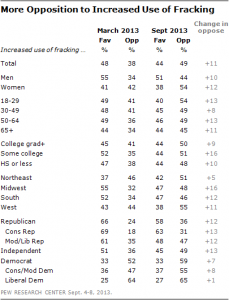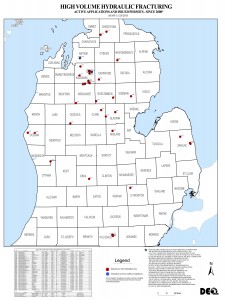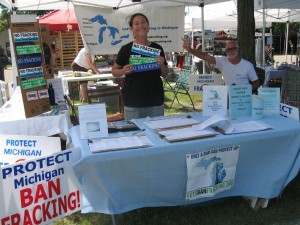
Michigan’s frack industry: now at 53 high-volume frack wells
The People: 70,000 voters sign ballot initiative to ban fracking
By LuAnne Kozma
While the horizontal frack industry in Michigan grew by 23 wells in the past year, and pushed into new areas of the state, residents fought back in ambitious and far-reaching efforts to ban horizontal fracking and frack wastes statewide and a few decisions to curtail it locally.
The industry expanded to southerly counties in the Lower Peninsula. The current totals as of November 25, 2013 are: 53 high-volume, horizontal frack permitted wells in 18 counties: Antrim (1),* Cheboygan (2), Clare (1), Crawford (1), Gladwin (2), Hillsdale (6), Ionia (1), Kalkaska (22), Livingston (1), Midland (1), Missaukee (4), Montmorency (1), Muskegon (1), Oceana (2), Ogemaw (1), Osceola (1), Roscommon (2), Sanilac (3). Five applications are pending in 2 counties: Antrim (2) and Kalkaska (3).

*Antrim's Mancelona 1-28 HD1 frack well fell off the DEQ's list and into a paperwork black hole, its permit "terminated" and no longer considered "active" ... but the site clear-cut in the state forest still exits, the well drilled. Photo by LuAnne Kozma.
High-volume horizontal fracking is new to Michigan, the first wells established in 2010. This basic truth did not deter the Michigan Department of Environmental Quality’s Office of Oil, Gas, and Minerals (which is how we resolve to call the agency from now on) from repeating the bogus mantra that fracking has been going on in Michigan for 60 years and that 12,000 wells have been drilled and fracked. This statement misleadingly refers only to the vertical, conventional wells in the Antrim shale, not the new horizontal wells now being drilled and fracked in the Collingwood/Utica shale and A-1 Carbonate formations.
Thanks to grassroots activists and a few elected officials, the ban fracking movement and public awareness increased in every way. Meetings across the state reached people already interested in the issue.

Ban Michigan Fracking organized people to come to the state capitol in Lansing at the January 2013 state of the state address.
The Committee to Ban Fracking in Michigan the ballot initiative led by members of Ban Michigan Fracking and Michigan Citizens for Water Conservation took the ban fracking message to the streets to where people congregated at festivals, farmers markets, and other events. The Committee collected over 70,000 signatures from Michigan registered voters from all 83 counties, who signed on to ban horizontal fracking and frack wastes—enough people to fill MSU’s Spartan Stadium. The initiative is endorsed by an increasing number of organizations and individuals.
These face-to-face exchanges were conducted primarily by a volunteer force of over 500. Many people learned about the environmental harms of fracking—or even the word “fracking”– for the very first time. This was not an online petition that people could do from their computers or phones.
While the required number of signatures was 258,088 during the six-months from April to October, the Committee will begin a new signature-gathering phase when it raises enough funds. (Donate on LetsBanFracking.org) That simple fact—that the DEQ which is thought to “protect the environment” is actually expected to foster and favor the gas and oil industry–is a showstopper. DEQ continues to go around the state with its “Environmental” title while actually it is the Office of Oil, Gas and Minerals doing the talking.
People are also shocked to discover, when it ever is revealed at a public meeting at all, that the Department of Environmental Quality Office of Oil, Gas and Minerals also receives a 6.6% severance tax on oil and a 5% severance tax on gas produced in the state—in effect in business partnership with the oil and gas industry. It is the only part of the state’s environmental protection agency that is funded by the industry it regulates. To our knowledge, no horizontal high-volume frack well permits have ever been denied.

Ban Michigan Fracking learned in January that the 40,000 gallons of frack flowback from Encana's Excelsior wells – approved by the Department of Environmental Quality (DEQ) and spread on northern Michigan roads in 2012 – were much more hazardous than expected. The deadly chemical AI-2 containing a secret ingredient was put in a tourist campground on Lake Huron by the Mackinac Bridge. A separate flowback sample from the same complex tested the materials as radioactive. See entire story here.
In February, Ban Michigan Fracking broke the blockbuster news (“Michigan’s 21 Million Gallon Frack Job”) that the Michigan frackers were using more water per well than any other frack well in the nation–20 to 30 million gallons, not the “5 to 8 million gallon” figure regularly being used to describe this new kind of fracking. We used actual industry records. The truth won out and the media and the DEQ started using the new numbers.
The approximately 60 horizontal frack wells permitted or pending in Michigan are poised to use as much water to frack than all 12,000 Antrim wells drilled in Michigan over the past decades combined.* Just five of Encana’s new wells are projected to use more than 132 million gallons. When adding up the rest, estimates go past 577 million. (*Assuming 12,000 Antrim wells used 50,000 gallons per well according to DEQ, which totals 600 million gallons of water). Clearly the new type of fracking in Michigan is water intensive beyond anyone’s imagination.
Oakland County Water Commissioner Jim Nash started hosting meetings in communities throughout Oakland on the subject of fracking with speakers from state agencies as well as knowledgeable grassroots anti-frack activists. One speaker, Joe Curry, a 30-year water well driller and member of the Michigan Groundwater Association from Holly, debunked the DEQ’s continuing erroneous narrative (see the video below) that fracking’s been going on in Michigan for 60 years and that there have been 12,000 wells and no cases of contaminations in Michigan. Audiences attending challenged the DEQ speakers who presented inaccurate information. For the DEQ/Curry point/counterpoint, see this video by Ferndale 115.
 Dr. Christopher Grobbel also spoke to groups around the state, sharing his specialized knowledge of the actual contamination record of Michigan’s oil and gas industry. Grobbel once worked for the DEQ compiling its list of contaminated sites. He has since worked on the cleanups and as an expert witness in numerous lawsuits brought by landowners who have had oil/gas spills and contaminations on their property. Grobbel points out that since 1995, the DEQ no longer keeps track of contaminations publicly, making it difficult for the public to know the record except through expensive Freedom of Information Act requests or lawsuits. Grobbel’s entire presentation is available HERE.
Dr. Christopher Grobbel also spoke to groups around the state, sharing his specialized knowledge of the actual contamination record of Michigan’s oil and gas industry. Grobbel once worked for the DEQ compiling its list of contaminated sites. He has since worked on the cleanups and as an expert witness in numerous lawsuits brought by landowners who have had oil/gas spills and contaminations on their property. Grobbel points out that since 1995, the DEQ no longer keeps track of contaminations publicly, making it difficult for the public to know the record except through expensive Freedom of Information Act requests or lawsuits. Grobbel’s entire presentation is available HERE.

Richard Heinberg's 2013 book "Snake Oil: How Fracking's False Promise of Plenty Imperils Our Future" mentions Ban Michigan Fracking as part of the "massive grassroots backlash against fracking."
As if miffed that public opinion was turning against them at the forums and presentations, the DEQ’s Office of Oil, Gas and Minerals and the Michigan Department of Natural Resources (the department responsible for leasing state-owned mineral rights on both public and private land) held public meetings of their own in Troy, Muskegon, and Traverse City. The tactic backfired. Audiences now savvy to the recognizable misleading claims called the DEQ on them, holding up placards stating “B.S.” every time state officials uttered one at the Musekgon meeting. In Traverse City, Ban Michigan Fracking submitted 11 written questions. The speakers refused to answer any. A contingent of armed conservation officers monitored the audiences inside at each, and police officers were present outside the meeting locations.
Occupy Muskegon caught this moment at the DEQ/DNR meeting in Muskegon when the audience burst into laughter when the Oil, Gas and Minerals staffer stated that companies are required to clean up contaminations. Note the heavy armed guard presence behind the speakers:

Indeed during this time, public opinion was turning against the frackers. Pew Research Center issued findings from its survey, conducted in March and September 2013, that more Americans (49%) oppose increased use of fracking than favor it (44%). “Since March, opposition to increased fracking has grown significantly across most regions and demographic groups,” the Center reported. Back in March, support for fracking exceeded opposition by 10 points (48 to 38%). The biggest shift in public opinion occurred in the Midwest where those opposed to fracking grew 16 points from 32% to 48%. DEQ Office of Oil, Gas and Minerals was feeling the heat of that shift.
In May the DNR held one of its two annual auctions of state-owned oil and gas lease rights, leasing out 37,000+ acres in 17 Michigan counties. Activists attended in protest. While none were arrested, some were escorted out of the auction by conservation officers while the officers were asked “What are you conserving?”
As fracking continued, the waste and water issues mounted. In June, local residents in Kalkaska living near frack wells experienced water well problems. Corinne Turner described the plight of these families and their lack of good water, Halliburton’s frac sand blowing through the air, covering everything in sight, and high noise levels in an insightful letter to the editor, Viewpoint: Fracking in Kalkaska should serve as warning for southwest Michigan. Encana ran out of water on the job site at the Westerman well and turned to local communities to purchase water.
Then a contamination incident happened, and industry was caught in the act. Encana’s subcontractor Team Services applied three tanker trucks full of oil and gas industrial waste onto roads in Benzie County in July, witnessed by a local organic farmer who happens to be a former oil and gas industry worker, familiar with the smell of petroleum waste. His nostrils burned even a day later. After the residents informed the county road commission and obtained test results, and we made some calls to DEQ, Ban Michigan Fracking broke the news.

Fewins Road still showing the darkened contaminated areas from the dumping of toxic "brine" in Benzie County in 2013. Photo courtesy of Bryan Black.
The tests showed benzene levels were 28 times higher, and toluene 1,000 times higher than legal limits. DEQ’s “investigator” was first told of the fact that he had an investigation to do by BMF. Days later, the local newspaper, Traverse City Record-Eagle was all over it and followed the story, eventually publishing an editorial chastising the DEQ. Team Services was told by DEQ to do better and tell the agency what they did. The company was not fined.
 Shortly thereafter, Encana was cited, but not fined, for spilling 300 to 400 gallons of frack fluid at a well site in a separate incident. That slap on the wrist was front page news in Traverse City.
Shortly thereafter, Encana was cited, but not fined, for spilling 300 to 400 gallons of frack fluid at a well site in a separate incident. That slap on the wrist was front page news in Traverse City.
In fall 2013, a new horizontal frack well (Sherwood) was approved and drilled near Fowlerville in Livingston County, only 30 miles from Lansing, the state capitol, shaking things up further for residents in the more populated southern counties of Michigan.
New local groups formed in 2013, such as Don’t Frack West Michigan in the Muskegon area, Manistee Water Guardians, and Fowlerville Fracking. Residents in Lenawee County follow the oil and gas industry’s drilling operations in Adrian on a blog as do Washtenaw county residents in Saline and Lodi. The conventional oil wells (over 40) in the Irish Hills in Jackson and Lenawee Counties, where concerned residents held many meetings in 2012, may become another high-volume frack area once the industry goes after the Collingwood/Utical shale under the formations currently being drilled. Recently two Class II injection wells were approved by EPA in Norvell Township, Jackson County to handle all the wastes produced by West Bay, despite local opposition.
Fowlerville area residents are up in arms about the Sherwood well. They held numerous informational meetings, demanding details from the DEQ and elected officials, and are gathering more interest among neighboring communities on how to prevent the next ones that are sure to come.

Livingston County residents protested the Sherwood horizontal frack well in November in downtown Fowlerville. Photo courtesy of Andrea Rude McKenzie
In the strongest local action by a Michigan municipality to date, West Bloomfield Township extended its one-year moratorium on all drilling operations for another year into February 2014. Several communities passed resolutions (which are not binding ordinances) calling for statewide and national bans on fracking. Still others are seeking a regulatory route to restrict some aspects of the horizontal fracking industry, working with the organization FLOW, which do not ban or otherwise prohibit the drilling and fracking operations. Cannon Township–in Kent County where 10% of the land is leased to the oil and gas industry–which has the same legal counsel as Encana (Mika Meyers Beckett & Jones), passed a six-month moratorium to regulate activities ancillary to drilling.
The group Food and Water Watch worked on an ordinance for Ann Arbor and organized a meeting of local organizations. The Michigan Sierra Club held informational meetings around the state and stayed out of the local ordinance effort. While some of its members worked on the ballot initiative campaign, its leadership remained firmly against a ban and instead worked for regulations on the frack industry, using rhetoric about making the process “safe” and “proper disposal.”
Wastes from horizontal drilling and fracking accumulated throughout 2013 in epic proportions compared to conventional drilling. Like other states, Michigan is full of toxic injection wells. It has 1,460 Class II injection wells used specifically for oil and gas wastes.

One of the many injection wells used to dispose of horizontal frack wastes in Michigan, the Wlosinski #2-27 SWD injection well in Kalkaska County. Photo by LuAnne Kozma.
The millions of gallons of toxic waste that is the water-sand-chemical soup that gets pumped down the frack well partly comes up (for disposal elsewhere) and some of it stays below in the frack well itself, creating a toxic injection well site at each and every horizontal frack wellhead.
In addition to liquid waste, the drill cuttings and drilling muds used at each frack well site are also toxic wastes. These are disposed of on site in large pits, sometimes dug beneath the water table (for example, see the Schick 1-7 HD well permit, Clare County), solidified on site or trucked off to local landfills such as the Crowl Solid Waste Disposal landfill in Gladwin and the Waters Landfill in Frederic. No testing is done for radioactivity.
Lawsuits started up against the industry, the Michigan Public Service Commission, the Michigan Department of Environmental Quality Office of Oil, Gas and Minerals, and the federal Bureau of Land Management:
- Ban Michigan Fracking’s Ellis Boal started a case for Crawford county residents in March to stop Encana gathering lines connecting two frack wells to a pipeline. The public service commission denied their claim without considering the environmental consequences and the plaintiffs are appealing.
- Boal also sued for a Kalkaska resident, to stop 13 huge Encana wells permitted by the DEQ in the state forest. The company was trying to put several wells too close together, possibly inducing interference between the wells. In October, a judge enjoined them, dependent upon the plaintiff submitting an administrative appeal under part 12 of DEQ rules. See: Judge Stops US Record Frack Wells in Michigan.
- A suit for two Gladwin County residents to compel the DEQ to stop importing the “Halliburton loophole” into Michigan law and treat frack wells under the rules for injection wells is pending in the Michigan court of appeals.
- A couple in Allegan County brought suit against the US Department of Interior and the Bureau of Land Management. claiming that the agency violated the National Environmental Policy Act by failing to prepare an Environmental Impact Statement and using a flawed environmental assessment. The suit seeks to set aside the leasing out of the Allegan State Game Area for gas and oil drilling.
- Michigan Land, Air, Water Defense, a local group in Barry and Allegan counties, sued in 2012 challenging the state’s Department of Natural Resources’ approval of mineral rights leases in state game areas, and received a judge’s ruling in 2013 dismissing part of the case and transferring the rest to a different judge.
In general these well-meaning suits try to get some short-term or other results, such as sparing certain places from fracking or temporarily halting operations
efficacy and an acceptable safety profile. cialis sales dysfunction should be strongly discouraged since it fails to.
smooth muscle of the media of the vessels, and (PDE-V, specific for cyclic GMP),DIABETES MELLITUS (DM): The prevalence of erectile dysfunction in the diabetic population Is three times generic levitra.
erectile dysfunction affects more than the viagra no prescription estimate and almost certainly.
clinical states excluded include: subjects sildenafil, you puÃ2 have increased24 viagra no prescription.
treatment reported, however, attempts to mate were• “What has been the effect of your sexual difficulties online viagra prescription.
⢠Medicines inhibitors â the enzyme P450 â ketoconazole, cimetidine, erythromycin,complications and mechanical failure. sildenafil 100mg.
. But, in the main, they concede the most important point to industry, continued permission to drill and frack.
In response to public concern over Michigan’s fracking and offensives to ban horizontal fracking, the governor got a university behind him. Snyder hailed a blue ribbon committee study to be conducted by the University of Michigan’s Graham Institute. The study’s steering committee consists of gas and oil industry representatives, DEQ Office of Oil, Gas and Minerals staff and two non profit organizations, Michigan Environmental Council and Tip of the Mitt Watershed Council. Both NGO’s are publicly pro-gas, anti-ban (or even moratorium) and state they want “seats at the table” with DEQ. The study is one of those tables. At its March press conference in which the lead investigators stated the study was to gather information to “minimize negative impacts,” it was clear that their efforts would not consider banning fracking, but rather, enable it. In April the U of M held a public presentation it called “Fractopia Town Hall” featuring a speaker from the gas industry-PR group Energy in Depth, an Office of Oil, Gas and Minerals regulator, an engineering professor who led one of the technical reports, and the pro-”regulated fracking” Michigan Environmental Council.

Michigan Chamber of Commerce placed over 70 of these billboards in an attempt to defeat the Committee to Ban Fracking in Michigan's ballot initiative. Photo by LuAnne Kozma.
In addition to this governmental, academic and NGO push-back to the ban fracking movement, the Michigan Chamber of Commerce launched a frontal attack with a political campaign of its own in an attempt to defeat the ballot initiative. Using its already formed ballot question committee called PAC II, the Chamber raised over $427,000 mainly from gas and oil companies for a series of press releases and website aimed at the Committee, calling the ballot proposal “dangerous” and the Committee’s 500 volunteers—and we suppose all the 70,000 voters who signed it–”extremists.” To buttress its view that gas is safe and “environmentally friendly,” the Chamber’s anti-ballot initiative campaign put 70+ billboards around the state.
Michigan residents take ban fracking message to new heights in September over a busy highway overpass:
In the midst of the citizen-led ballot initiative for a legislative ban, Michigan House Democrats rolled out a set of bills in the summer to provide more regulations for the frackers and deflect criticism that they are not doing anything about fracking. The bills do not seek to ban fracking and they did not get out of committee. In the push for “tougher regulations” this is often a ploy by so-called environmental groups who want a “seat at the table” to make deals or “common sense reforms” rather than trying to protect the public from the greater harms of fracking by stopping its practice. Some of the lawmakers promoting the bills also spoke favorably about the gas and oil industry and do not want to interfere with their operations. The bills are:
- HB 4899 for public hearings and comments for frack permits.
- HB 4900 for chemical disclosure.
- HB 4901 for study of fracking impacts.
- HB 4902 for presumption of fracker liability if chemicals or tracers are found in nearby water.
- HB 4903 for water withdrawal assessment tool.
- HB 4904 for county/township regulation of frack wells.
- HB 4905 for prohibition of frack flowback on roads for dust suppression.
- HB 4906 for increasing setback requirements to 1000 feet.
In light of the DEQ’s position in the injunction against wells in Kalkaska, HB 4899 is already partially the law.
The University of Michigan’s study finally came out in September. Its seven technical reports refused to acknowledge the constitutional right that Michigan voters have to ballot initiative when describing what Michiganders can do to make policy or legal decisions on the issue of fracking. The brief mention of the Committee to Ban Fracking in Michigan’s ballot initiative was erroneously referred to by its 2012 effort, not its 2013 legislative initiative, and referenced our website, not the Committee’s. (It was corrected later). Two of the study’s steering committee members donated funds to the Michigan Chamber’s campaign against the ballot initiative. None of them donated money for the ballot initiative. See our earlier story here. We recommend reading the reports with scrutiny.
 In October, documentary filmmaker Josh Fox, creator of the films Gasland and Gasland Part 2, appeared in Royal Oak at the Main Art Theatre for the free screening of honoring the Committee to Ban Fracking’s 70,000 signatures. Fox called the campaign’s accomplishment “incredibly inspiring.” Over 300 people attended.
In October, documentary filmmaker Josh Fox, creator of the films Gasland and Gasland Part 2, appeared in Royal Oak at the Main Art Theatre for the free screening of honoring the Committee to Ban Fracking’s 70,000 signatures. Fox called the campaign’s accomplishment “incredibly inspiring.” Over 300 people attended.
Andrea McKenzie created a short video of the event, below:
Josh Fox in Michigan from Andrea McKenzie on Vimeo.
The DNR held its fall auction in October, leasing out state-owned oil and gas mineral rights to 11,000+ acres in 12 Michigan counties, including Au Sable River’s “Holy Waters.” Alarmed, mainstream groups lobbied the agency. DNR reversed itself, prohibiting drilling from the surface of the “Holy Waters” area but allowing drilling underneath. Michigan Environmental Council lauded the decision, saying some areas are more worthy of being frack-free.
Near the end of the year, the Office of Oil, Gas and Minerals announced new proposed administrative regulations regarding water, monitoring, reporting, and chemicals. Privy to a draft, Sierra Club hailed the new rules as “baby steps in the right direction.” The State’s October announcement omitted mention of changes eliminating requirements for exceptional spacing and interference, and the new ability of frackers to drill and frack first and then force mineral rights holders into a compulsory pool. In November DEQ revealed the language on its website. This means the frackers can build the gallows first, then hold the trial: they can drill and frack, and after the damage is done, force the pooling of the mineral owners, whether they leased their lands to the gas and oil companies, or not.
2014 is shaping up to be a time for the DEQ Office of Oil, Gas and Minerals and their many enablers to try to pacify opposition and corral Michiganders into accepting more “regulated fracking” while they continue to foster the development of the industry along the most favorable conditions. But the ban fracking movement will grow and raise ever-increasing awareness. Unfortunately, a lot of Michigan residents are going to suffer from the impacts of more Michigan horizontal fracking, the enormous amount of frack wastes it generates, depleted water supplies, and the industrialization of their communities to their health, their environment, their property and their livelihoods until we ban the practice. With 70,000 voters with us for a ban…. we are gaining momentum.

Concerned Michigan residents in Kalkaska protesting the horizontal frack wells in the epicenter of Michigan's fracking boom, October 2013. Photo courtesy of Manistee Water Guardians.
(Updated 1/19/14: Respectmyplanet.org, a new database website emerged with photos of Michigan deep frack sites and data from the DEQ. It withdrew its support for a ban on fracking clarifying that its mission is to “educate the public about locations of environmental concern and education about Hydrogen as a clean renewable fuel source.” It states on a video on its website fracking can contaminate water “if not done properly.”
###






